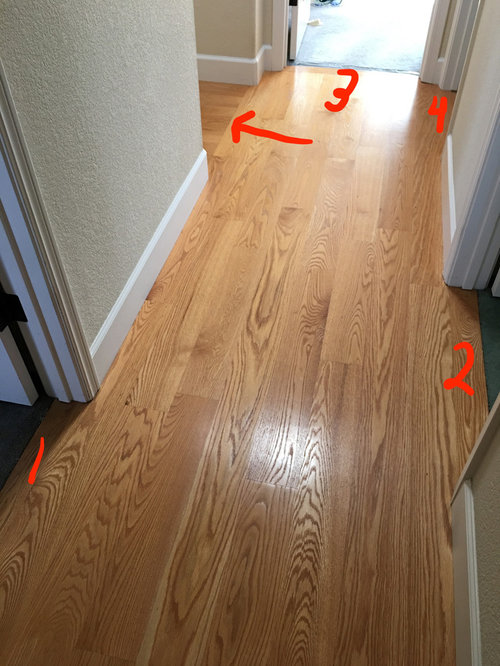Picture this: you’ve finally found the perfect wood flooring for your home, but you’re met with a hurdle – a concrete subfloor. Can this dream be realized? Will your beautiful wood flooring look out of place? The answer, thankfully, is a resounding yes! Laying wood flooring over concrete is a common and achievable project, but it requires careful planning and execution. This comprehensive guide will equip you with the knowledge and confidence to tackle this project successfully.

Image: carpet.vidalondon.net
Wood flooring on concrete offers numerous benefits. Beyond aesthetics, it provides warmth and insulation, enhancing both comfort and energy efficiency. It can even contribute to a quieter living space by absorbing noise. However, the unique properties of concrete require special considerations to ensure the success of your project and the longevity of your flooring.
Understanding the Challenges and Solutions
The main challenge in laying wood flooring on concrete lies in the concrete’s inherent characteristics. Concrete is inherently rigid, which can lead to sound transference, making the floor feel hollow or echoing. Concrete also has varying moisture levels which can lead to warping, buckling, and even mold growth if not properly addressed. Furthermore, concrete surfaces can be uneven, which can affect the overall appearance and stability of the flooring.
Thankfully, solutions exist for each of these challenges. To address sound transference, a layer of underlayment is often used, providing a buffer between the concrete and the wood flooring. This underlayment can be made of various materials such as foam or cork, each offering different levels of soundproofing and insulation.
To manage moisture levels, it’s essential to ensure the concrete subfloor is dry. A moisture test is recommended before installation to determine the moisture content and whether any measures need to be taken, such as installing a moisture barrier or allowing the concrete to dry further.
For uneven concrete surfaces, a self-leveling compound can be applied to create a smooth and level surface, providing an ideal foundation for the flooring.
Choosing the Right Flooring
Not all wood flooring is created equal when it comes to laying over concrete. Consider the following factors to ensure you select the right type:
- Solid Wood Flooring: Beautiful and durable, solid wood flooring can be a great option for concrete subfloors, but it requires some careful considerations. Since it’s thicker than engineered wood flooring, it can be more susceptible to warping due to moisture variations.
- Engineered Wood Flooring: Engineered wood flooring offers more stability than solid wood flooring, making it a good choice for concrete subfloors. It’s engineered to be less prone to warping and is often more affordable than solid wood.
- Click-Lock Flooring: Click-lock flooring features a unique locking mechanism, making installation quick and straightforward. This type of flooring is ideal for DIY projects and is often available in a variety of wood species, styles, and finishes.
Preparation is Key
Proper preparation is the backbone of a successful wood flooring project. Before beginning the installation, ensure the following steps are taken:
- Check for Moisture: A moisture test is essential to determine the moisture content of the concrete subfloor. If moisture levels are high, allow the concrete to dry further or install a moisture barrier.
- Clean the Subfloor: Thoroughly clean the concrete subfloor, removing debris, dust, and any loose particles.
- Leveling: If the concrete subfloor is uneven, apply a self-leveling compound to create a smooth and level surface.
- Install a Moisture Barrier: A moisture barrier, such as a polyethylene sheet, can be installed to prevent moisture from migrating up from the concrete subfloor.
- Install Underlayment: Installing underlayment on top of the moisture barrier provides a cushion between the concrete and the wood flooring, reducing noise and adding insulation.
- Acclimate the Flooring: Before installation, allow the wood flooring to acclimate to the room’s temperature and humidity for a few days. This helps minimize expansion and contraction after installation.

Image: viewfloor.co
Installation Methods
Once the subfloor is prepared, you can begin installing the wood flooring. There are two primary methods:
- Nail-Down Installation: This traditional method involves driving nails through the flooring into the subfloor. It’s typically best suited for solid wood flooring and requires expertise for proper execution.
- Floating Installation: This method involves interlocking panels of wood flooring without using nails or glue. Floating installation is often faster and easier than nail-down methods and is well-suited for click-lock flooring.
Expert Insights and Actionable Tips
- Professional Consultation: If you’re unfamiliar with laying wood flooring, consider seeking expert advice from a flooring contractor. They have the knowledge and experience to ensure a successful installation.
- Consider DIY Options: With proper planning and preparation, laying wood flooring on concrete can be a rewarding DIY project. Numerous online resources and tutorials can provide step-by-step guidance.
- Maintenance is Key: Once your wood flooring is installed, regular maintenance is essential. This includes sweeping or vacuuming regularly, cleaning spills promptly, and applying a sealant periodically.
Can You Lay Wood Flooring On Concrete
Conclusion
Laying wood flooring on concrete is an achievable project that can transform the look and feel of your home. By understanding the challenges, choosing the right flooring, and addressing preparation and installation considerations, you can bring your dream flooring to life. Remember, proper planning and execution are key to achieving a successful and long-lasting result.
If you’re ready to embark on this rewarding project, consider consulting with a flooring professional and researching online resources to gather further insights and guidance. Happy flooring!






